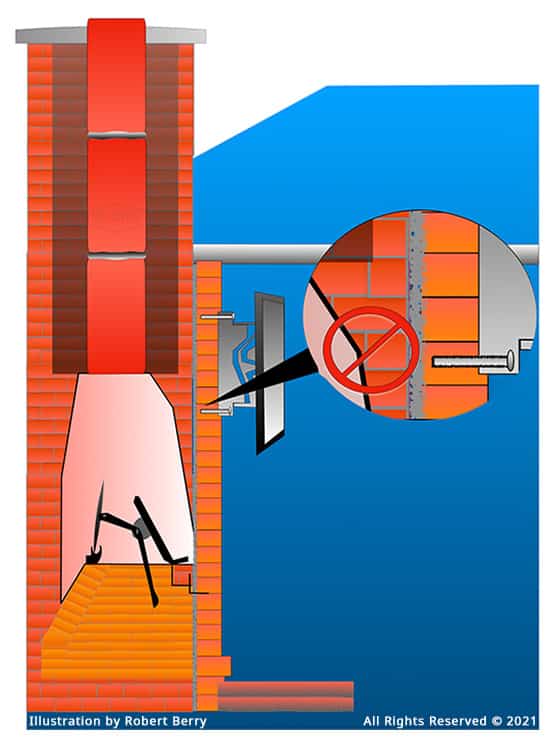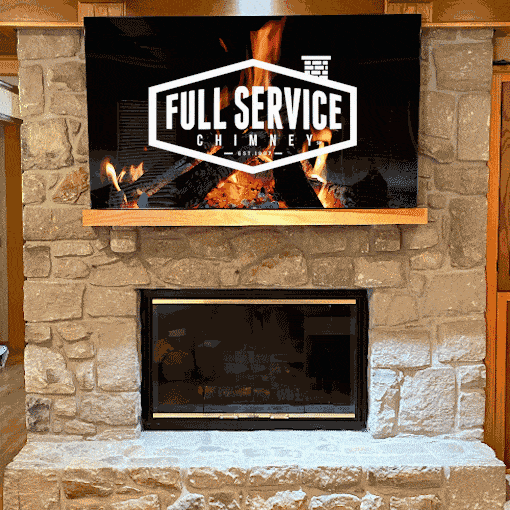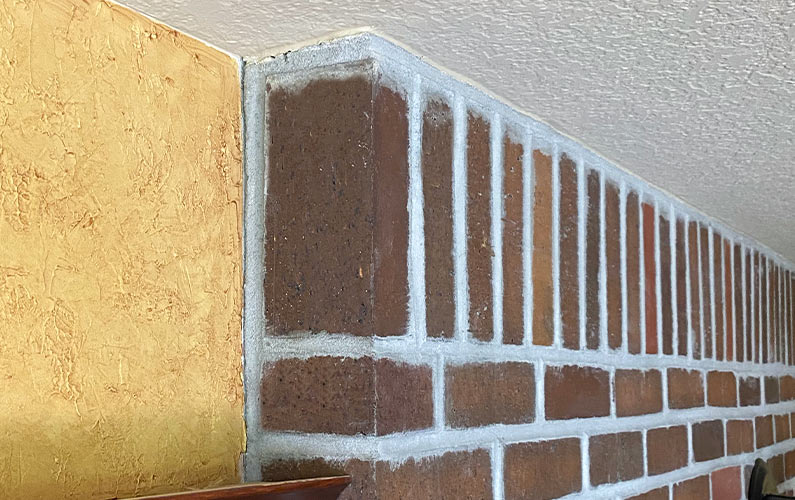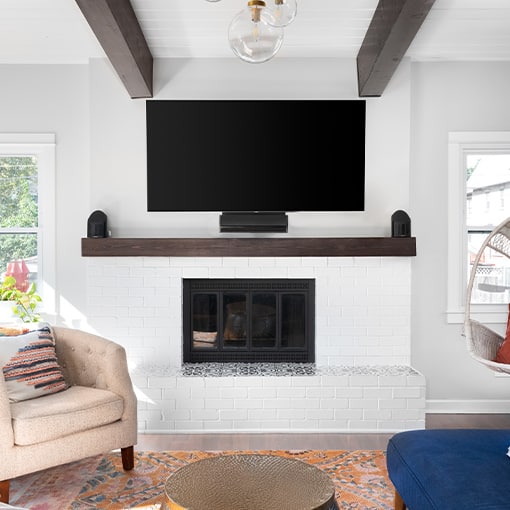When it comes to mounting a tv above a fireplace, simply put, what works for someone else may not work for you. That’s because every home’s fireplace system is entirely different.
There are so many factors involved that it takes the trained eye of a professional to know and consider all factors. Proceeding with this seemingly simple project could be a costly mistake.
Ask yourself a few questions and consider the following things before starting this popular household project:
- Understand why the construction of the facing around and above is a factor to consider
- Use only the right sized anchors/fasteners
- Be aware of the risks involved before drilling into your fireplace surround
- Be familiar with all internal fireplace/chimney system components
- Know the difference between glue and mortar
- Understand that TVs and Heat do NOT go together
- Do you have the right type of fireplace and TV for Mounting?
- How to know if a TV can go above your open-fireplace
- Consider the seating requirements and viewing angles
- Have you ever considered a projector TV?
- The risks of using full-motion wall mounts
- Consider the television weight, type of tv mount, and if the two are appropriate for your specific fireplace wall/facing, etc.
Why Understanding Mortar is Important to your TV Mount & Fireplace Project
If you’re wondering why we’re talking about bricks and mortar instead of tv mounts, it’s because it’s extremely relevant to your home fireplace project.
Whether you have a masonry or a prefabricated system, your fireplace surround/facing is likely held in place by mortar on your chimney/wall.
The fireplace surround is unique to every single home. We’ve been to thousands of homes and never come across one that’s exactly like another, which is why we cannot in good conscience give an exact recipe for how to mount a tv above a fireplace. Not without thoroughly inspecting the area and all components therein.
As you can see, the mortar is holding the brick facing on the wall.
Use only an appropriately sized anchor for your specific setup
We cannot recommend the correct size because every home has a unique fireplace and hearth setup. So what works at your neighbor’s house may very well not work for your home.
You’ll want to use multiple right-sized anchors… 4-inches is usually good. Just remember you’re attaching a heavy object to a structure that MIGHT not be as sturdy as sheetrock and 2×4 wall.
Remember, you’re bolting the television to a single wall of brick, NOT the chimney.
Another thing to remember is that this project requires more than your standard drill and drill bit set. Here are a few tools you’ll likely need to mount a tv above a fireplace: Anchors, a hammer drill, a high-impact drill and bits, and a dry shop vacuum.
Don’t let common sense mislead you when choosing your mounting anchors
When planning this project, you’ll likely consider the weight of a big-screen television. It might even SEEM like a great idea to use extra-long anchors to make sure your fireplace tv is mounted in the brick or wall solid enough that it won’t shift or fall out. However, that common sense is misleading in this case. Allow us to explain:
First, while there may be times when it works, if you’re not familiar with the inner workings of your fireplace and chimney, then we advise you NOT to use extra-long anchors unnecessarily. When doing so, you’d run the risk of causing damage to a structure; this is difficult and costly to repair.
An example of potential damages to a masonry chimney caused by using anchors that are too long is they could drill too far through and accidentally penetrate the chimney’s smoke chamber or ceramic flue tiles. The smoke chamber and flue tiles contain the smoke on its way outdoors.

Using extra-long anchors poses the risk of penetrating the smoke chamber or flue tiles, leading to major safety hazards.
What do you think happens if we unknowingly drill a hole through that barrier between the smoke and the living room?
That’s right; it could become a safety hazard. Chances are, not much will get through if there’s a bolt filling the hole; however, let’s say the first attempt at hanging the TV on the mount above the mantel didn’t go as planned and needs moved, leaving open holes and hidden puncture damage. Smokey exhaust and gases, such as carbon monoxide, can seep through the new openings that shouldn’t be there.
Or maybe you mount your television using a fastener that’s a little bit too long, but there’s nothing that immediately alerts you to the problem. The TV looks great, and everything appears to be okay. But what you don’t know is that there’s a tiny puncture wound in the chimney’s ceramic flue tile behind the fireplace wall, which is just the start of progressive damages.
It happens over time, and in a situation like this, you may not find out about the damage until your next level 2 inspection.
This is when your chimney tech runs a high-resolution camera up the flue and finds the spot right behind where the fireplace tv mount has started cracking.
Every time you’ve used the fireplace, the heat only aggravates that crack, making it bigger and spreading it until repairs or a complete rebuild is necessary.
Now ask yourself if that TV mounting was worth a repair job that could easily cost you tens of thousands of dollars.
If you’re not sure about the current state of your fireplace facing or chimney, schedule an inspection with one of our certified chimney professionals.
Your masonry fireplace surround is actually part of the home, not the chimney
Did you know that the surrounding area of a masonry fireplace, otherwise known as the outer hearth (the whole indoor area around and above your hearth) and the fireplace facing is not part of the chimney structure, but it’s a part of your home? Believe it or not, it’s true.
A fireplace facing is the part of your hearth that belongs to the house’s interior, and the chimney stack is an exterior feature. It’s often difficult for many people to understand. Even within the chimney and fireplace industry, it is difficult to grasp without visualizing it.
We’re going to explain it further, but we need you to understand a bit about bricks and mortar.
Mortar is NOT Glue
Although mortar is commonly called the “glue that holds bricks together,” mortar is NOT an adhesive glue.
While it’s not directly related to your fireplace’s TV installation, if you’re like us, and love to learn new things, here’s a cool video that goes a bit more in-depth on what exactly mortar is, how this bonding material was invented centuries ago, and why it’s still being used every day on job sites like ours.
Mortar is essentially like a space filler. A bonding substance that fills the spaces in between blocks or bricks and then hardens. When blocks/bricks interlock with mortar, it becomes tight-fitting and sturdy.
During a chimney’s construction, the builders will often construct the fireplace and chimney structure and then a week later return to build the outer fireplace hearth, making them two separate structures bonded together with mortar.
Master Chimney Sweep Robert Berry has seen this scenario countless times in his 33+ years rebuilding fireplaces and their chimneys. Here’s what he had to say:
“The bricks or blocks that you see on and around your fireplace is not actually attached to the chimney behind it, rather only lightly bonded with a thin layer of mortar between the interior and the exterior structures. After years without maintenance, the outside “tall tower” part of a chimney may start to lean or tilt, pulling away from the house and when this happens the stack of bricks pulls away from the mortar, too.”
Heat & TVs Don’t Mix
Heat and television, or any other electronics for that matter, aren’t designed to get along. When it comes to mounting your television above your fireplace, it’s best to play it safe and know which fireplaces are less likely to cause you problems with overheating and which types you should avoid mounting a tv above.
Why can I not use a tv mount with a gas insert or wood stove fireplace? Because the nature of those is to make a lot of heat… which can harm the delicate electronic components inside the television.
As always, when in doubt, call a professional for help.
Mount Your TV Above an Open-Fireplace
While you can usually get away with mounting a flat-screen tv over an electric fireplace, when it comes to gas or wood-burning units made to produce heat, you must be careful what you place above the mantel. Even direct vent gas fireplace and inserts produce a substantial amount of heat that can eventually deem your television useless. You won’t notice the damage until the day comes when the television refuses to turn on.
In most cases, you should not install electronics above wood-burning stoves or gas fireplaces and inserts because they produce massive amounts of heat. That heat could severely damage your tv or other electronic devices.

An open fireplace that burns wood or decorative gas logs, which has non-removable glass doors (with gaskets and a tight-fitting latch) or air-tight doors, would frequently allow a TV to stick out from the facing IF said television was mounted in excess of 12 inches above the opening or fireplaces lintels.
Take this Quick QUIZ to Determine if a Mount Can Work for You
- Does your fireplace have air-tight doors that open with a latch?
- Does your fireplace produce heat?
- Does it have a single fixed sheet of glass in a frame, held in place with springs and a clamp?
If the answer is yes to ANY of those questions, then heat could become a problem for the TV mounted above your fireplace.
Some other things that could be problematic:
-
- Are there any cracks or movement in your masonry? If so, this is not a good fit for tv mounting.
- Is your facing brick or rock veneer? If so, then this is not best for mounting TVs on.
Consider the seating requirements for comfortable viewing
We know hanging your TV above the fireplace or mantel is a trendy thing to do these days, but before grabbing your drill and a new mount, perhaps the best place to start is asking yourself this question:
Do you really want the television above eye level?
If so, you’ll need to determine if your fireplace room is large enough to accommodate this arrangement for comfortable screen viewing?
If you’re not sure, test it out. That’s what we did, and we go into detail about those test results below.
Consider the proper angle for viewing LED/LCD Televisions
When trying to relax and watch our favorite shows, we all want the best possible viewing conditions. The first thing to consider is the angle at which most modern LED/LCD televisions, especially the older plasma model TVs, have a limited angle at which the picture is clearly seen.
If you’ve ever looked at flat-screen television from a different angle, rather than head-on, eye-level, then you know exactly what we mean. There are newer OLED model televisions that don’t have this problem, but we won’t cover those in this article.
So, now to find out how far back to put a couch or recliner chairs away from a TV hung over the fireplace. Using the television mounted above our 75-inch fireplace, where the center of the flat-panel screen is approximately 7-feet above the floor.
Our goal was to determine how far away we must sit from the tv mounted above the mantle not to need to lookup. Our reason for doing this is to avoid getting neck pain. Anyone who’s ever watched a whole movie from the front row of a movie theater can understand why this is important!
Measure for Seating with TV Wall Mount
| Seating Distance from Television | Comfort Level |
| Under 8 feet | Suffered Neck Strain. Had to bend neck to look up enough to cause significant neck pain after a while. |
| At around 8 -10 feet | Suffered Eye Strain. Able to look straight ahead but had to look up, causing eyes to feel strained. |
| At around 15 ft | Mostly Comfortable Viewing. The neck and eye strain was reduced and at a comfortable level for viewing. The only issue at 15 ft. is the distance may be a problem for people with poor eyesight or smaller televisions. |
What to do if you can’t mount a television over your fireplace
So what if you’ve discovered that this is not going to work out as you’d hoped. Are you bummed about not being able to attach a TV above your fireplace?
If you’ve done your research and maybe even consulted a professional but still determined that your original plan for your fireplace tv mounting project is not a good fit for your current home, that’s okay. We’ve got good news! There’s another way.
Have you ever considered a Projector TV?
Projector technology has come a long way and is much higher quality than they ever were before! The projector shines an image onto a lightweight screen. These modern devices are a real convenience that attaches to a ceiling instead of a wall.
Many of them also have remote-controlled opening and closing capabilities that allow you to hide the screen quickly!
The projector box itself can also be concealed in a decorative cabinet when not displayed. They can now even work in well-lit rooms, which wasn’t possible with early projector models.
What is the best surface for a wall-mounted TV? A wall of course
If you have a plain fireplace wall (2×4 and sheetrock) above your fireplace where the brickwork stops above the opening and is regular drywall, consider the projector to shine directly on the wall and, once prepared with the paint, mimics a projector screen and produces a pretty nice image.
Using Full-Motion Wall Mounts to Angle your Television
Many people frequently wonder what tv mounts to use above your fireplace. If you want full tilt and swivel options for your tv, there are full-motion, “accordion” style wall mounts with articulating arms that allow you to move your television in all different directions once it’s mounted.
These are great for a standard wall (assuming you know how to use a stud finder and choose the right sturdy spot to hang your tv).
We love that these mounts move in different directions and provide mobility to your television if you need it. However, If the wall above the mantle is a brick or stone veneer, we do NOT recommend using adjustable mounts on the facing above your fireplace.
These full-motion bracket mounts pose a risk when hanging it on a fireplace surround and facing. (*See the section on mortar for a more in-depth understanding).
Usually, the brick, rock, tile, or stone veneer facing a fireplace is held onto the wall by a thin layer of mortar. Now, bolting in a heavy object on that facing places a lot of strain on a pretty important piece of your room!
TV Weight is a Heavy Concern for a Fireplace Surround
As mentioned above, the weight of the electronic device you’re mounting is a concern you must take seriously. Think about it. New tv models (under 65-inch) are fairly lightweight (50-65 lbs). The older flat panels typically weigh between 80-100 lbs. Add in the weight of the mount itself, which is usually over 30 lbs.
You could easily have at least 100 lbs. of torque, where the mount is bearing the weight of the television and trying not to break the wall or facing behind it. And depending on the wall’s material, age, or current physical state, cracking or collapsing is a real possibility and concern.
The leverage of a cantilever arm helps move heavy objects but puts more of the load on the wall itself. When that “wall” is sometimes as little as 4-inches thick and attached to a thin layer of mortar, that weight could now be too much to hold.
We Recommend: The type of mounts that do NOT move or adjust are the safest to use when mounting a tv above a fireplace, especially when attached to fireplace facing.
Summary
Mounting a tv above your fireplace is a wonderful idea for combining beauty, comfort, and entertainment in your home; however, just because it’s a good idea in theory doesn’t mean it’s the right idea for you specifically.
It’s imperative to remember that every home’s fireplace and chimney system is different from the rest. That’s why there’s no “one size fits all” approach to tv mounts.
And as we detailed in this blog, whether or not a typical flat screen above the fireplace is the right option for you depends on several factors.
When it comes to home improvement projects that could substantially impact you financially or the safety of your fireplace, it’s always better to be safe than sorry. So, before you embark on this tv mount journey, we strongly suggest that you consult with a professional. Regardless of the result, we hope this blog acts as a jumping-off point to kick-start your project!
Check out some other posts from our blog…




